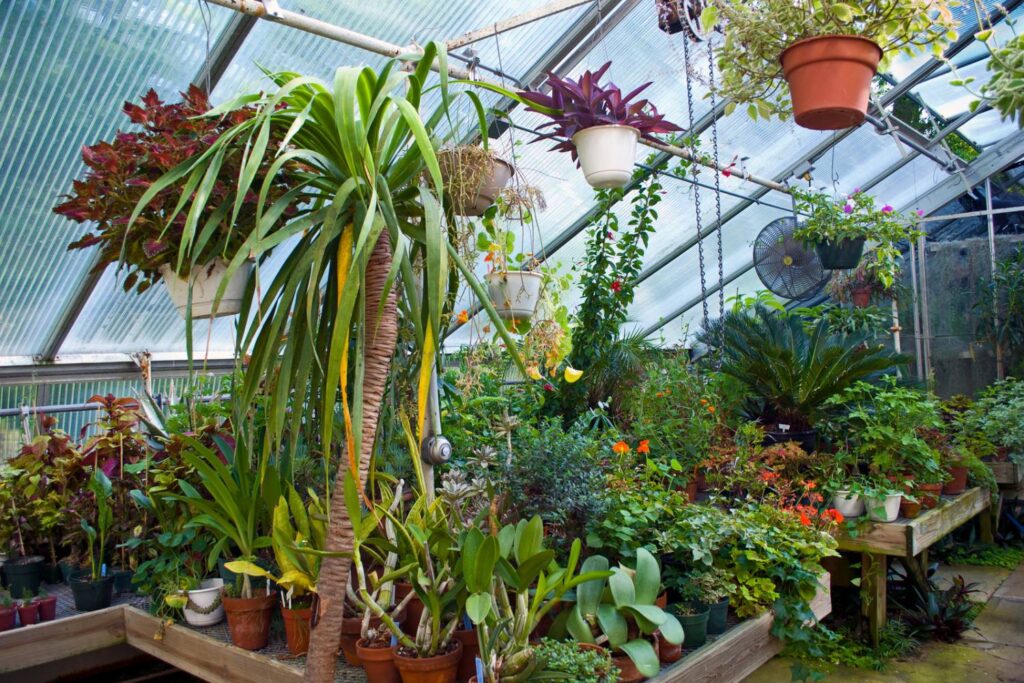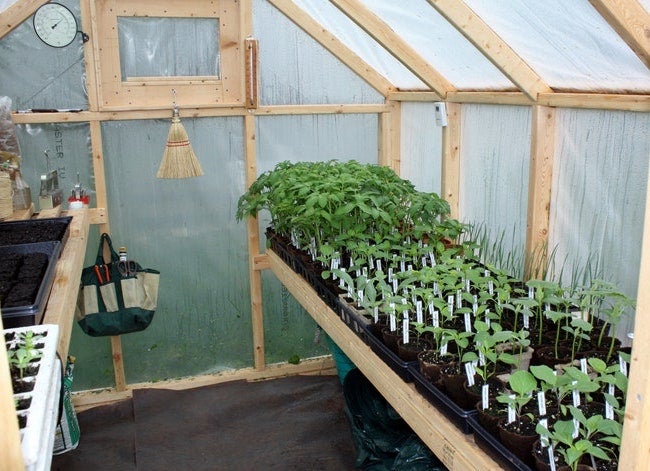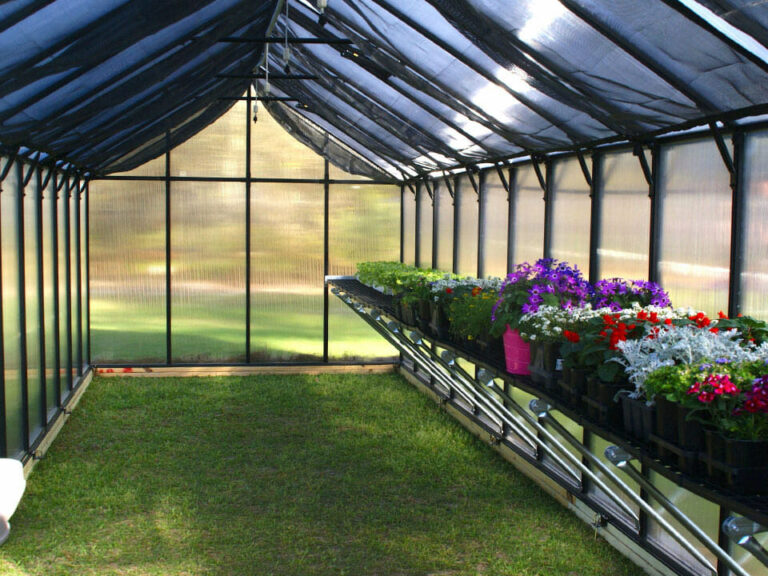When I entered the world of gardening, I couldn’t help but wonder about a crucial question: What’s the right temperature for a greenhouse at night? This question led me on a journey to understand how to create the perfect environment for my plants after the sun goes down.
A clear, starry night, a gentle breeze gently moving the leaves, and me standing by my greenhouse. It’s a haven of life and growth, filled with the scent of blooming flowers and the soothing sound of rustling leaves.
However, what really matters during these nighttime hours is the temperature inside the greenhouse, as it can determine whether my beloved plants thrive or struggle.
Join me on this illuminating journey as we delve into the depths of greenhouse temperature management.
The ideal nighttime temperature for a greenhouse depends on the plants you’re growing:
- Cool-tolerant plants: 45°F to 55°F (7°C to 13°C).
- Warm-tolerant plants: 50°F to 70°F (10°C to 21°C) or higher.
- Avoid frost by keeping it above 32°F (0°C).
- Adjust based on plant needs, local climate, and season.
- Use monitoring and automation for temperature control.
What Are the Ideal Nighttime Temperatures for Greenhouses?

Discovering the perfect nighttime temperatures for your greenhouse is key to fostering optimal plant growth and vitality.
Cool-Tolerant Plants
Range: 45°F to 55°F (7°C to 13°C)
Cool tolerant plants are those that can withstand and even thrive in cooler temperatures. This temperature range of 45°F to 55°F (7°C to 13°C) is suitable for crops like lettuce, spinach, and certain herbs.
Moreover, these plants have adapted to cooler conditions and can continue growing during the night without adverse effects. Maintaining a slightly lower temperature can also help conserve energy and reduce heating costs in the greenhouse.
However, it’s essential to monitor these plants closely as temperatures approach the lower end of this range. Extended periods of temperatures near 45°F (7°C) may slow down growth, so adjustments might be necessary based on plant development and local climate.
Warm-Tolerant Plants
Range: 50°F to 70°F (10°C to 21°C) or higher
Warm-tolerant plants, including tomatoes, peppers, and tropical species, require higher nighttime temperatures to thrive. In this range of 50°F to 70°F (10°C to 21°C) or even higher, these plants can continue their growth and development during the night.
Going below this range can lead to stress, slowed growth, and potentially damage to sensitive plants.
In addition, it’s particularly crucial to maintain these temperatures when growing warm-season crops in cooler climates or during colder seasons. Supplemental heating may be necessary to achieve and sustain these temperatures, ensuring that your plants remain healthy and productive.
Frost Prevention
Keep above 32°F (0°C)
Regardless of the types of plants in your greenhouse, it’s vital to prevent frost during the night. Frost can be highly detrimental to most plants, causing cell damage and even death.
In addition, keeping the temperature above freezing, ideally at or above 32°F (0°C), is crucial for protecting your crops from frost damage.
To achieve frost prevention, greenhouse operators often use heaters, insulation, and thermal curtains to trap heat and maintain a stable temperature above freezing.
Moreover, monitoring systems and automated controls can help ensure that your greenhouse remains frost-free, safeguarding your plants, especially during cold nights or in regions prone to frost.
What Factors Influence Greenhouse Temperature?
Understanding the multifaceted factors that influence greenhouse temperature is essential for creating the perfect environment for your plants to thrive.
Seasonal Variations
Seasonal variations have a significant impact on the nighttime temperature requirements for a greenhouse:
Winter: During the winter, external temperatures drop significantly, requiring more active heating within the greenhouse to maintain the desired nighttime temperature.
In colder climates, frost protection becomes critical. Greenhouse operators may need to use heating systems, insulation, and thermal curtains to keep temperatures within the optimal range.
Spring and Fall: These transitional seasons can bring fluctuating temperatures. Greenhouses need to adapt to these changes by using a combination of heating and natural ventilation to achieve the right nighttime temperatures.
Furthermore, cold nights might necessitate heating, while milder nights can benefit from passive cooling methods to prevent overheating.
Summer: In the summer, external temperatures can rise, potentially leading to overheating within the greenhouse during the day. Proper ventilation and shading systems are essential to prevent daytime temperatures from getting too high.
At night, natural cooling methods can be employed to lower temperatures to the desired range for warm-tolerant plants.
Local Climate Conditions
The local climate plays a crucial role in determining the nighttime temperature requirements for a greenhouse:
Geographic Location: Greenhouses in different geographic regions will experience varying climate conditions. Coastal areas tend to have milder winters, while inland and high-altitude locations might face harsher cold spells.
Moreover, understanding the specific climate of your location helps in planning temperature control strategies.
Microclimates: Even within a relatively small area, there can be microclimate variations. Factors like proximity to bodies of water, wind patterns, and altitude can create microclimates that impact nighttime temperatures.
Monitoring and adapting to these microclimates are essential for greenhouse management.
Extreme Weather Events: Consideration must be given to extreme weather events such as cold snaps, heatwaves, or storms that can affect nighttime temperatures.
Furthermore, preparing for these events with backup heating or cooling methods can safeguard your plants.
Plant-Specific Requirements
Different plants have specific temperature requirements based on their natural habitats and growth stages:
Origin and Adaptation: Plants originating from different regions of the world have varying temperature preferences. Understanding the native habitat of your plants can help you mimic their ideal conditions in the greenhouse.
Growth Stage: The temperature needs of plants can change as they progress through different growth stages. Seedlings and young plants often require warmer conditions, while mature plants may tolerate slightly cooler nighttime temperatures.
Varietal Differences: Even within the same plant species, different varieties or cultivars can have varying temperature tolerances.
Crop Goals: Your goals for your crops also influence temperature management. For example, if you aim to extend the growing season or force early flowering, you may need to provide specific temperature conditions during the night.
How to Optimize Temperature Management in Your Greenhouse?

Unlocking the secrets to effective temperature management in your greenhouse is a vital step towards maximizing your crop yield and plant health.
Monitoring Tools
Monitoring tools are essential for maintaining optimal nighttime temperatures in a greenhouse. These tools provide real-time data and allow growers to make informed decisions:
Thermometers: Accurate thermometers placed strategically throughout the greenhouse help you track temperature variations.
However, digital thermometers are often preferred for precise readings. Wireless or remote monitoring systems can transmit data to your computer or smartphone, enabling remote monitoring.
Hygrometers: These devices measure humidity levels, which can indirectly affect the perception of temperature by plants. Managing humidity is critical for temperature control and disease prevention.
Data Loggers: Data loggers record temperature and humidity data over time, providing historical insights.
Moreover, they are useful for tracking trends, identifying temperature fluctuations, and making adjustments to your temperature management strategy.
Environmental Control Systems: These sophisticated systems integrate various sensors and controls.
In addition, they can automatically adjust heating, cooling, and ventilation equipment to maintain desired temperature and humidity levels.
Automation and Heating Systems
Automation and heating systems are crucial for precise temperature control, especially during cold nights:
Heating Systems: Greenhouses commonly use heating systems such as gas or electric heaters, radiant heating, or hot water systems.
Moreover, these heaters maintain the greenhouse temperature by supplying heat when needed. Thermostats can be used to set temperature thresholds and regulate the heating system.
Thermal Curtains: Insulating thermal curtains are deployed at night to trap heat inside the greenhouse. They are often used in conjunction with heating systems to reduce energy costs and maintain stable temperatures.
Automated Vents: Roof vents and side vents can be automated to open or close based on temperature and humidity levels.
Furthermore, this natural ventilation allows excess heat to escape during the day and prevents temperature drops at night.
Climate Control Computers: These systems integrate sensors, actuators, and a computerized control unit to manage temperature and humidity.
Moreover, they can adjust heating, cooling, ventilation, and shade systems automatically, ensuring precise temperature control.
Insulation: Proper greenhouse insulation minimizes heat loss at night. Insulating the greenhouse structure, particularly the walls and roof, helps maintain a more stable temperature, reducing the need for continuous heating.
Natural Ventilation and Cooling
Natural ventilation and cooling are essential for preventing overheating during the day and reducing the need for excessive nighttime heating:
Roof and Side Vents: These openings allow hot air to escape and fresh air to enter during the day. Automated vents are controlled based on temperature and humidity, helping to maintain a comfortable environment for plants.
Shade Systems: Shade cloths or screens can be used to reduce solar radiation and heat buildup during sunny days. Moreover, they are particularly useful in warmer climates or during the summer months.
Evaporative Cooling: This technique involves spraying water or using evaporative cooling pads to lower temperatures inside the greenhouse. As water evaporates, it cools the air, providing natural cooling on hot days.
Fans and Circulation: Proper air circulation using fans helps distribute temperature and humidity evenly throughout the greenhouse.
In addition, this prevents temperature stratification and ensures that all plants receive consistent conditions.
FAQ’s
Do greenhouses stay warm at night?
Greenhouses can stay warmer at night compared to the external environment, especially if they have proper insulation and heating systems.
What temperature should a greenhouse be at day and night?
The ideal temperature for a greenhouse during the day is typically between 70°F to 75°F (21°C to 24°C), and at night, it varies depending on the plants, but it can range from 45°F to 70°F (7°C to 21°C).
What temperature is too hot for a greenhouse?
Greenhouses can become too hot if the temperature consistently exceeds 90°F to 100°F (32°C to 38°C) for extended periods. This excessive heat can stress or damage plants.
Can I leave my greenhouse open at night?
Leaving a greenhouse open at night depends on the outside temperature and the specific needs of your plants. In mild weather, ventilation can be beneficial, but during cold nights, it’s important to maintain a suitable temperature with proper insulation and heating.
Are greenhouses cold at night?
Greenhouses can be cooler at night than during the day, especially in the absence of heating. Proper temperature management is crucial to prevent nighttime cold stress on plants.
Do greenhouses overheat?
Yes, greenhouses can overheat, especially on sunny days. Adequate ventilation, shading, and cooling methods are essential to prevent overheating and maintain a suitable environment for plants.
Do greenhouses work without sun?
Greenhouses can still function without direct sunlight, as they provide a controlled environment that protects plants from extreme conditions. Supplemental lighting can be used to support plant growth in low-light conditions or during the winter months.
Final Words
In conclusion, as a greenhouse operator, I recognize the critical importance of nighttime temperature management in optimizing plant growth and ensuring the success of my cultivation efforts. Understanding the specific temperature needs of cool-tolerant and warm-tolerant plants, as well as the imperative of frost prevention, guides my decisions.
Additionally, I acknowledge the multifaceted nature of temperature control, considering seasonal variations, local climate conditions, and the unique requirements of my plant species. My commitment to effective temperature management is evident through the use of monitoring tools to gather real-time data, automation systems, and heating equipment to maintain stability, and natural ventilation and cooling strategies to prevent overheating.
By incorporating these practices, I aim to create a greenhouse environment that fosters healthy and productive plant growth while conserving resources and energy for sustainable cultivation.

